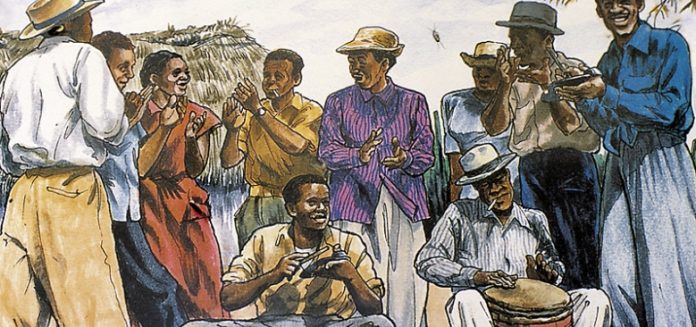As the last weeks of this year are approaching and a new decade is before us, it is essential to highlight an irreplaceable traditional intangible cultural heritage of Aruba, the Dande. Even though between Aruba, Bonaire, and Curaçao there are many shared cultural traditions, the Dande is something uniquely from Aruba and can’t be found on the other islands.
According to UNESCO, cultural heritage “does not end at monuments and collections of objects. It also includes traditions or living expressions inherited from our ancestors and passed on to our descendants, such as oral traditions, performing arts, social practices, rituals, festive events, knowledge and practices concerning nature and the universe or the knowledge and skills to produce traditional crafts”.
While delicate, intangible cultural heritage is a significant aspect in preserving cultural diversity in the face of growing globalization. The general understanding of intangible cultural heritage of different communities on Aruba helps with intercultural discourse, community cohesion and supports mutual respect for other ways of life. The meaning of intangible cultural heritage is not only the cultural manifestation but rather the richness that is diffused from one generation to the next. UNESCO reiterates that “the social and economic value of this transmission of knowledge is relevant for minority groups and for mainstream social groups within a State, and is as important for developing States as for developed ones”. Summarized we can conclude that Intangible Cultural Heritage is: 1. Traditional, contemporary and living at the same time; 2. Inclusive; 3. Representative; and 4. Community-based.
Dande.
The most traditional cultural intangible heritage Aruba has throughout the Christmas season is called Dande. The Dande is a local oral tradition where the song “ay nobe” (aña nobo) – “new year” is performed as the New Year is approaching or has arrived. Dande stems from the word Dandalia, which loosely translates into “to party, he who parties, or simply paranda”. The first sentence of the Dande song “oh dande nos a jega na bo porta” – Ay Nobe, translated means “Oh the party has arrived at your door” – New Year. The origin of the Dande is not known, however there are many theories such as; 1. Its starting in the district of Savaneta, 2. Its starting in the district of Noord, 3. Its popularity strengthened in the district of St. Cruz, or 4. Its starting after the abolition of slavery in 1863 by the Dutch King.
A group of five or sometimes even six people (one singer accompanied by numerous musicians) usually performs the most known Aruban end of the year tradition. These people, usually family members accompany a singer and travel door-to-door to express their best wishes for the New Year in repetitive phrases (blessings), with a chorus that includes the phrase “ay nobe” (aña nobo) – “new year” – sung after each blessing. Currently, the celebratory travel usually leads to the houses of the singers’ friends and family, where the singer collects money in his hat to give to the group. Traditionally the removal of the singer’s hat is considered a sign of respect he/she is expressing to the family and person they are singing to and blessing. Instead of money, back in the day, the singer would receive food (for example pan dushi “sweet bread”) in their hat as a token of gratitude for their long trip. The singer starts by blessing the head of the house and then one by one passes to every person present. Besides visiting local houses on New Year’s Eve and the day after, the Dande tradition is very popular on the last working day of the year. Local businesses invite a Dande group to come and bless their workers and the company as the New Year approaches.
This tradition is so prominent in the Aruban culture that a festival was organized four decades ago to preserve this cultural tradition for the future in a form of a competition. In 1973 Harry Croes took the initiative of organizing a Dande Festival considering the declining popularity of the Dande and also with the hope of preserving the one unique cultural heritage tradition of the island. Originally the Dande Festival was for adults only, but 12 years ago Commission Promove Cultura organized the first festival for children and teenagers. Now, this festival is very popular and many tipico’s “local bands” and performers compete every year to receive the ultimate prize, becoming the Dande King or Queen. It is considered a big honor each year as children, young adults and adults participate and help the Aruban tradition stay alive.
UNESCO World Heritage List vs. Intangible Cultural Heritage.
UNESCO is internationally known for their World Heritage List of Tangible heritage sites all over the world. These sites include landmarks, buildings, and other tangible artifacts. Many culture loving people travel to numerous countries just to visit these sites. Intangible Cultural Heritage (ICH) is a program initiated in 2001 by UNESCO to recognize and protect various cultures and practices that, unlike items on the UNESCO World Heritage List, cannot be touched. Therefore, Intangible cultural heritage “includes song, music, drama, skills, crafts, and the other parts of culture that can be recorded but cannot be touched and interacted with, without a vehicle for the culture”. UNESCO divides the list into three different categories: 1. The representative list comprises cultural “practices and expressions that help demonstrate the diversity of this heritage and raise awareness about its importance”; 2. The safeguarding list is composed of cultural elements that are threatened and in need of urgent measures to keep them alive; 3. The best practice list is comprised of the best examples by communities and governments of the protection and recognition of intangible cultural heritage. Practices that can be accepted within these categories include: Oral traditions and expressions, including language as a vehicle of the intangible cultural heritage; Performing arts; Social practices, rituals and festive events; Knowledge and practices concerning nature and the universe; and Traditional craftsmanship. The hope remains that Aruba and all relevant Aruban Civil Society Organizations (CSOs) help safeguard the Dande tradition internationally.
Next year, further discussion will be provided on the topic on ICH and how Aruba can be part of the world’s biggest cultural safeguarding community. But, in the spirits of Christmas, the Creative Islander would like to extend its best holiday wishes to you and your entire family during the Christmas season. The gift of love. The gift of peace. The gift of happiness. May all these be yours at Christmas and throughout the New Year. Till next year!q












